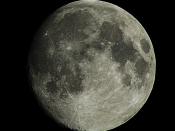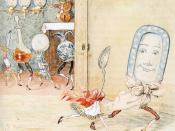In every culture, the moon has been a mythological figure, probably because it is viewed by everyone and up until recently not much was known about it. In the majority of cultures, the ruler of the moon is a goddess. But in other cultures, the moon holds magical potions, comes from a violent source, and in one, the moon is a live entity. Although all ancient cultures looked at the moon differently, it was always one of the most important elements to them. The moon is also a huge figure in poetry and nursery rhymes.
In Africa, the moon is known as Mawu. Mawu is the supreme God of the Fon people of Abomey (a small part in Northwest Africa). It brings cooler temperatures to the hot continent of Africa and is seen as an old mother from the West. Mawu is famous because she and a partner known as Liza created the world.
The used their son, Gu, to shape the universe. Gu is known as the divine tool.
The Aztecs looked at the moon in a much darker way than Africans did. It would remind them of violence. According to Aztec mythology, the moon goddess is Coyolxauhqui. The name Coyolxauhqui means "Golden Bells". Coyolxauhqui is the daughter of the Earth goddess, Coatlicue, and the sister of Huitzilopochtli, the Sun God. According to legend, Coyolxauhqui believed her mother was dishonest and encouraged all of her four hundred brothers and sisters to kill their mother. When Coatlicue gave birth to Huitzilopochtli, He was fully armed at birth. Huitzilopochtli didn't like what Coyolxauhqui was trying to do so he cut off her head and threw it up into the sky. Coyolxauhqui's head became the moon.
Hinduism has a very interesting view on how the world is. They believe that every...


